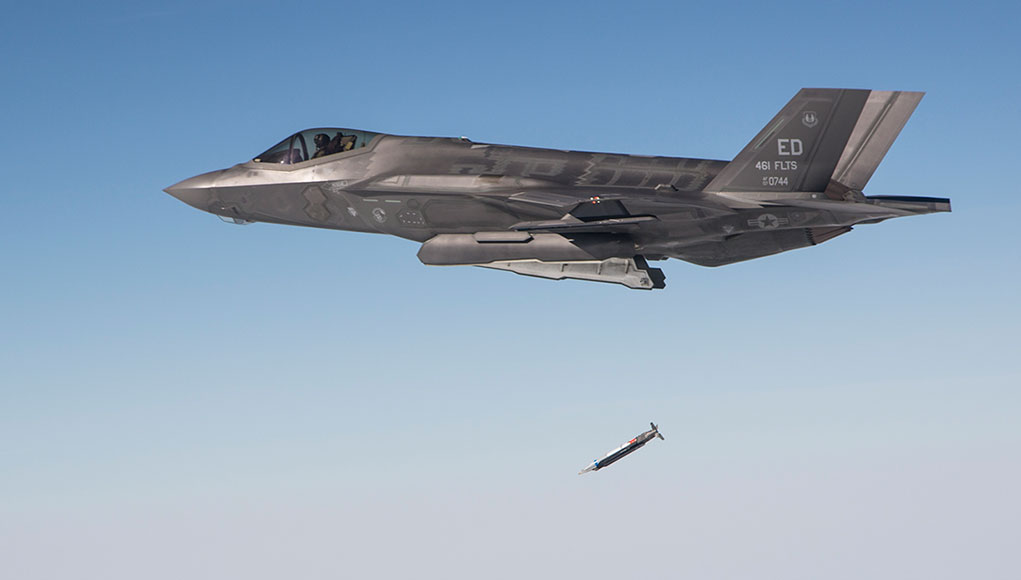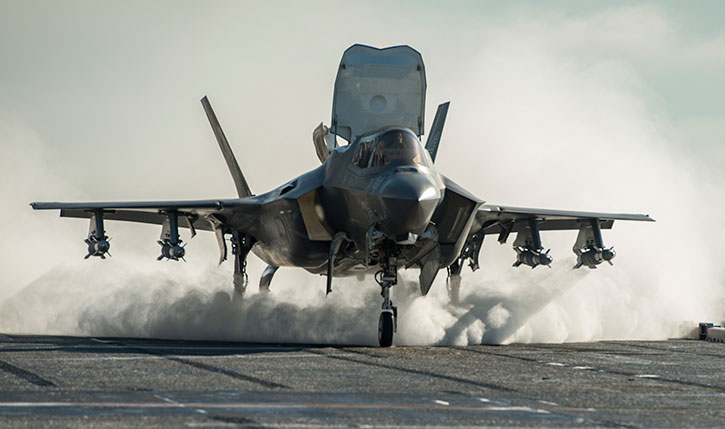A Gunslinger with Bad Eyesight
Other shortfalls encountered with the F-35 last year concerned the fire control and gunsight. During aerial firing of the gun pilots realized issues with gun aiming and accuracy. In particular the aiming reticule shown on helmet mounted display was unstable in marking aimpoints and tracking the targets, both air-to-ground and air-to-air starfing. Again, due to late discovery of this issue fixes will not be available soon.

The Armor Piercing Explosive (APEX) ammunition used for the weapon proved suitable and effective against air and ground targets, including soft targets, vehicles and personnel in the open, but required a modification of the fuse to improve its efficiency against armored targets.
CAS With Workarounds
Much of the scrutiny of the F-35 program was on its ability to support ground forces through Close Air Support missions. As a modern and more capable successor to F-16, F-15, F/A-18, A-10 and AV-8B, the F-35 should be ready to conduct CAS. Such mission is most critical for the US Marine Corps, requiring a near term replacement for AV-8B. The replacement of the Air Forces’ A-10C by the F-35A remains in debate, at least for the next few years.
However, test and evaluation have indicated that the F-35, at least in the Block 2b and Block 3i configurations are not yet ready for serious CAS, equivalent to the capabilities of the fourth-generation aircraft it is intended to replace. The F-35A in the Block 3i configuration has numerous limitations that make it less effective overall in the CAS mission role, in a permissive or low-threat environment, which is where CAS is normally conducted.
When tested in the air-to ground gun strafing the symbology, displayed in the helmet, was unusable and potentially unsafe to complete the planned testing. The air-to-air mode proved more stable but testers reported the pipper symbology (on the helmet display) was unstable while tracking a target aircraft. However, the funnel version of the air-to-air gunsight appeared to be more stable in early testing. Fixing these deficiencies may require changes to the mission systems software that controls symbology to the helmet, or the radar software.
The aircraft is currently certified to carry weapons internally, thus being limited to a loadout of two bombs and two air/air missiles. Furthermore, an aircraft-mounted gun is a key weapon for some CAS scenarios when a bomb cannot be used due to collateral damage concerns or when the enemy is “dangerously close” to friendly troops. The gun can also be an effective weapon for attacking moving targets. However, even though an internal gun is installed in the Block 3i F-35A, it cannot be used until significant modifications to both the gun system and aircraft are completed, and a version of Block 3f software is tested and delivered to fielded aircraft.
Another issue is the capability of the F-35 to engage moving targets. Without a functioning gun, and lacking certain fire-control capabilities, limiting the laser guided bomb carried by the aircraft to use automated targeting functions with lead-laser guidance, like most legacy aircraft can. As a stop-gap, F-35 pilots use basic rules-of-thumb when attempting to engage moving targets with the GBU-12, resulting in limited effectiveness.
Other methods would use two-ship “buddy lasing” for GBU-12 employment, which consumes more assets and is not always possible during extended CAS engagements. The Air Force is considering integrating the GBU-49, a fielded weapon that has similar size, weight and interfaces as the GBU-12, or a similar weapon that does not require lead-laser guidance, in Block 3f. Otherwise, the program plans to develop and field lead-laser guidance in Block 4.2, which would be delivered in 2022, at the earliest.
Unlike legacy aircraft, Block 2B aircraft will need to make substantial use of voice communications to receive targeting information and clearance to conduct an attack during Close Air Support (CAS) missions due to the combined effects of digital data communications deficiencies, lack of infrared pointer capability, limited ability to detect infrared pointer indications from a controller (which may be improved in the Generation III Helmet Mounted Display System (Gen III HDMS), and inability to confirm coordinates loaded to GPS-aided weapons. Each of these shortfalls limit effectiveness and increase the risk of fratricide in combat.

Continue to the next part: Searching for (Targeting) Solutions




















